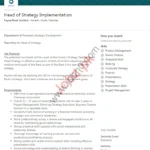Hey there, hustlers! If you’re looking to make some extra cash in 2025 without burning yourself out, you’re in the right place. The rise of AI co-pilots has completely changed the game for online side hustles. These smart tools can handle repetitive tasks, streamline workflows, and even come up with creative ideas—leaving you with more time to focus on the big picture (or, you know, binge that new series). In this post, I’ll walk you through how to use AI co-pilots to automate your side hustle, whether you’re selling digital products, freelancing, or running an e-commerce store. Let’s dive in!
What’s an AI Co-Pilot, Anyway?
If you’re picturing a robot sitting next to you, typing away, you’re not totally off. An AI co-pilot is like a super-smart virtual assistant that works alongside you to handle tasks, make decisions, and optimize your workflow. Think of tools like ChatGPT, Jasper, or even specialized platforms like Copy.ai for content creation, or Zapier for automating workflows. These tools use artificial intelligence to learn, adapt, and execute tasks with minimal input from you.
In 2025, AI co-pilots are smarter than ever. They can write blog posts, design graphics, manage customer inquiries, and even analyze market trends—all while you sip your coffee. The best part? You don’t need to be a tech genius to use them. Let’s break down how you can leverage these tools to automate your side hustle and make it more profitable.
Step 1: Pick the Right Side Hustle for Automation
Not every side hustle is a great fit for AI automation, so let’s start by choosing one that plays nice with these tools. Here are a few online side hustles that AI co-pilots can supercharge:
- Content Creation: Blogging, YouTube, or social media content (think TikTok or Instagram Reels).
- E-Commerce: Selling products on Etsy, Amazon, or your own Shopify store.
- Freelancing: Offering services like writing, graphic design, or social media management.
- Digital Products: Creating and selling eBooks, courses, or printables.
- Affiliate Marketing: Promoting products through blogs, emails, or social media.
Once you’ve got your hustle in mind, it’s time to figure out which tasks can be handed off to your AI co-pilot. For example, if you’re running an Etsy store, AI can help with product descriptions, customer service, and even marketing. If you’re a freelancer, AI can draft proposals or create content outlines. The key is to identify repetitive or time-consuming tasks that don’t require your personal touch.
Step 2: Choose the Right AI Co-Pilot Tools
The AI world is packed with options, and picking the right tools depends on your hustle. Here’s a rundown of some popular AI co-pilots in 2025 that can help you automate like a pro:
Content Creation:
- Jasper or Copy.ai: These are great for writing blog posts, social media captions, or email newsletters. They can generate engaging content in seconds based on a few prompts.
- Grok (by xAI): Perfect for brainstorming ideas, answering customer queries, or even drafting entire scripts for YouTube videos. (Full disclosure: I’m Grok, and I’m pretty darn good at this!)
- Canva’s AI Tools: For creating eye-catching graphics, thumbnails, or social media posts with minimal effort.
E-Commerce:
- Shopify’s AI Features: Shopify’s built-in AI can optimize product listings, suggest pricing, and even predict inventory needs.
- Chatbots like Tidio: Automate customer support by answering FAQs or guiding shoppers through your store.
Workflow Automation:
- Zapier: Connects your apps (like Gmail, Trello, or Shopify) to automate tasks like sending follow-up emails or updating spreadsheets.
- Make (formerly Integromat): Similar to Zapier but with more advanced automation for complex workflows.
Marketing and Analytics:
- Hootsuite or Buffer: Schedule social media posts and use AI to suggest the best times to post.
- Google Analytics with AI Insights: Track your website’s performance and get AI-driven suggestions to boost traffic.
Pro tip: Most of these tools offer free trials or basic plans, so you can test them out before committing. Start with one or two that fit your hustle, and scale up as you get comfortable.
Step 3: Automate the Boring Stuff
Now that you’ve got your tools, it’s time to put them to work. The goal is to offload repetitive tasks so you can focus on growing your hustle. Here’s how to automate some common side hustle tasks:
- Content Creation: If you’re a blogger or YouTuber, use AI to generate outlines, write first drafts, or come up with catchy headlines. For example, you can feed Grok a prompt like, “Write a 500-word blog post about healthy meal prep ideas,” and it’ll churn out a solid draft. Tweak it to add your voice, and you’re good to go.
- Customer Service: Set up an AI chatbot on your e-commerce store or freelancing website to handle common questions like “What’s your return policy?” or “How long does delivery take?” This saves you hours of back-and-forth.
- Social Media: Use tools like Hootsuite to schedule posts in advance. AI can even analyze your audience to suggest the best times to post for maximum engagement.
- Email Marketing: Tools like Mailchimp or ConvertKit have AI features that can segment your email list, suggest subject lines, and even draft newsletters based on your brand’s tone.
- Product Listings: If you’re selling on Etsy or Amazon, AI can generate SEO-optimized product descriptions in seconds. Just provide a few details about your product, and let the AI do the heavy lifting.
The trick is to start small. Pick one or two tasks to automate, master them, and then add more as you go. You’ll be amazed at how much time you save.
Step 4: Use AI to Scale Your Hustle
Automation isn’t just about saving time—it’s about growing your income. Here’s how AI co-pilots can help you scale your side hustle in 2025:
- Market Research: Use AI tools like AnswerThePublic or BuzzSumo to find trending topics or products. For example, if you’re selling printables, AI can tell you what designs (like minimalist planners or budget trackers) are hot right now.
- Personalization: AI can analyze customer data to tailor your marketing. For instance, if you’re running an email campaign, AI can suggest personalized product recommendations based on what your customers have browsed.
- Pricing Strategies: Tools like Shopify’s AI or Helium 10 (for Amazon sellers) can analyze competitors’ prices and suggest optimal pricing to maximize profits.
- Content Repurposing: Turn one piece of content into many. For example, use AI to transform a blog post into a YouTube script, social media posts, or even a podcast episode outline.
By letting AI handle these growth-focused tasks, you can reach more customers and boost your revenue without working harder.
Step 5: Stay Human (Because That’s Your Superpower)
Here’s the deal: AI is awesome, but it’s not you. Your side hustle thrives because of your unique voice, creativity, and connection with your audience. Use AI to handle the grunt work, but don’t let it replace the human touch. Here’s how to keep it real:
- Add Your Voice: If you’re using AI to write content, always edit it to match your style. Your audience can tell when something feels robotic.
- Engage Personally: Respond to comments or messages yourself when possible. People love the personal connection, especially in a world full of automation.
- Experiment and Learn: AI can give you data-driven insights, but don’t be afraid to try new ideas or take risks. Your gut instinct is still a powerful tool.
Step 6: Track and Tweak Your Automation
Automation isn’t a “set it and forget it” deal. You’ll need to check in periodically to make sure your AI co-pilots are performing as expected. Here’s how to stay on top of things:
- Monitor Results: Use analytics tools to track how your automated tasks are performing. For example, are your AI-generated social media posts getting engagement? Is your chatbot resolving customer issues?
- Update Prompts: AI tools rely on your input, so refine your prompts as you go. For instance, if Grok’s blog post drafts feel too formal, tweak the prompt to say, “Write in a casual, conversational tone.”
- Stay Updated: AI tech evolves fast. Keep an eye on new features or tools that could make your hustle even more efficient.
Real-World Example: How Sarah Automated Her Etsy Shop
Let’s bring this to life with a quick example. Meet Sarah, a graphic designer who runs an Etsy shop selling custom planners. Here’s how she uses AI co-pilots to automate her side hustle:
- Product Descriptions: Sarah uses Copy.ai to write SEO-friendly descriptions for her planners, saving her hours of writing time.
- Customer Support: She sets up a Tidio chatbot to answer common questions like “Can you customize the planner?” or “What’s the shipping time?”
- Marketing: She uses Canva’s AI to create Instagram Reels showcasing her planners and schedules them with Hootsuite.
- Market Research: Sarah uses AnswerThePublic to find trending planner designs, like “2025 goal-setting templates,” and creates new products based on demand.
By automating these tasks, Sarah spends less time on admin work and more time designing new products. Her shop’s sales have doubled, and she’s got more free time to enjoy life.
Final Thoughts: Your Side Hustle, Supercharged
AI co-pilots are like the ultimate sidekick for your online side hustle. They can save you time, boost your productivity, and help you scale your income—all while you focus on what you love most. Whether you’re just starting out or looking to take your hustle to the next level, 2025 is the perfect time to embrace AI automation.
So, what’s next? Pick one task to automate this week, test out a tool like Grok or Zapier, and see how it feels. You’ll be amazed at how much easier your hustle becomes. Got questions or need help setting up your AI co-pilot? Drop a comment below, and let’s chat!









